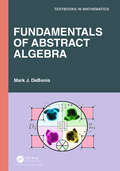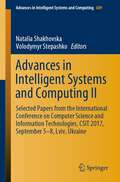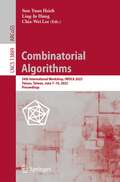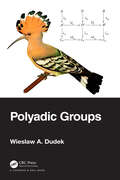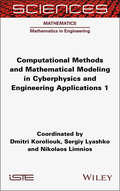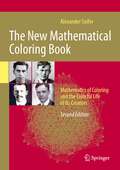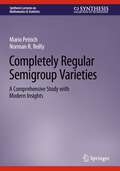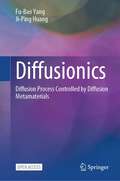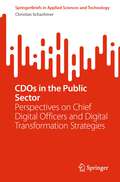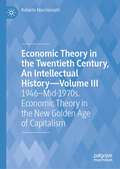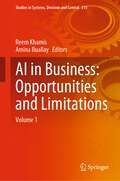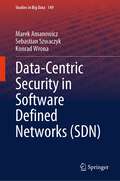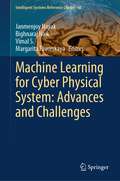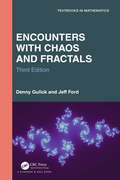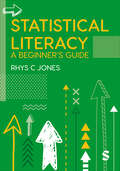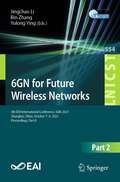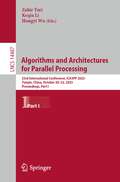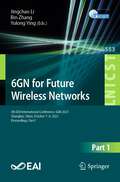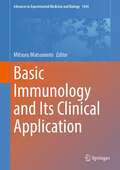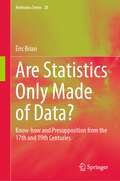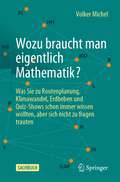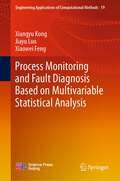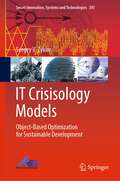- Table View
- List View
Fundamentals of Abstract Algebra (Textbooks in Mathematics)
by Mark J. DeBonisFundamentals of Abstract Algebra is a primary textbook for a one year first course in Abstract Algebra, but it has much more to offer besides this. The book is full of opportunities for further, deeper reading, including explorations of interesting applications and more advanced topics, such as Galois theory. Replete with exercises and examples, the book is geared towards careful pedagogy and accessibility, and requires only minimal prerequisites. The book includes a primer on some basic mathematical concepts that will be useful for readers to understand, and in this sense the book is self-contained.Features Self-contained treatments of all topics Everything required for a one-year first course in Abstract Algebra, and could also be used as supplementary reading for a second course Copious exercises and examples Mark DeBonis received his PhD in Mathematics from the University of California, Irvine, USA. He began his career as a theoretical mathematician in the field of group theory and model theory, but in later years switched to applied mathematics, in particular to machine learning. He spent some time working for the US Department of Energy at Los Alamos National Lab as well as the US Department of Defense at the Defense Intelligence Agency, both as an applied mathematician of machine learning. He held a position as Associate Professor of Mathematics at Manhattan College in New York City, but later left to pursue research working for the US Department of Energy at Sandia National Laboratory as a Principal Data Analyst. His research interests include machine learning, statistics and computational algebra.
Fundamentals of Abstract Algebra (Textbooks in Mathematics)
by Mark J. DeBonisFundamentals of Abstract Algebra is a primary textbook for a one year first course in Abstract Algebra, but it has much more to offer besides this. The book is full of opportunities for further, deeper reading, including explorations of interesting applications and more advanced topics, such as Galois theory. Replete with exercises and examples, the book is geared towards careful pedagogy and accessibility, and requires only minimal prerequisites. The book includes a primer on some basic mathematical concepts that will be useful for readers to understand, and in this sense the book is self-contained.Features Self-contained treatments of all topics Everything required for a one-year first course in Abstract Algebra, and could also be used as supplementary reading for a second course Copious exercises and examples Mark DeBonis received his PhD in Mathematics from the University of California, Irvine, USA. He began his career as a theoretical mathematician in the field of group theory and model theory, but in later years switched to applied mathematics, in particular to machine learning. He spent some time working for the US Department of Energy at Los Alamos National Lab as well as the US Department of Defense at the Defense Intelligence Agency, both as an applied mathematician of machine learning. He held a position as Associate Professor of Mathematics at Manhattan College in New York City, but later left to pursue research working for the US Department of Energy at Sandia National Laboratory as a Principal Data Analyst. His research interests include machine learning, statistics and computational algebra.
Advances in Intelligent Systems and Computing II: Selected Papers from the International Conference on Computer Science and Information Technologies, CSIT 2017, September 5-8 Lviv, Ukraine (Advances in Intelligent Systems and Computing #689)
by Natalia Shakhovska Volodymyr StepashkoThis book reports on new theories and applications in the field of intelligent systems and computing. It covers computational and artificial intelligence methods, as well as advances in computer vision, current issues in big data and cloud computing, computation linguistics, and cyber-physical systems. It also reports on data mining and knowledge extraction technologies, as well as central issues in intelligent information management. Written by active researchers, the respective chapters are based on papers presented at the International Conference on Computer Science and Information Technologies (CSIT 2017), held on September 5–8, 2017, in Lviv, Ukraine; and at two workshops accompanying the conference: one on inductive modeling, jointly organized by the Lviv Polytechnic National University and the National Academy of Science of Ukraine; and another on project management, which was jointly organized by the Lviv Polytechnic National University, the International Project Management Association, the Ukrainian Project Management Association, the Kazakhstan Project Management Association, and Nazarbayev University. Given its breadth of coverage, the book provides academics and professionals with extensive information and a timely snapshot of the field of intelligent systems, and is sure to foster new discussions and collaborations among different groups.
Combinatorial Algorithms: 34th International Workshop, IWOCA 2023, Tainan, Taiwan, June 7–10, 2023, Proceedings (Lecture Notes in Computer Science #13889)
by Sun-Yuan Hsieh Ling-Ju Hung Chia-Wei LeeThis book constitutes the refereed proceedings of the 34th International Workshop on Combinatorial Algorithms, IWOCA 2023, held in Tainan, Taiwan, during June 7–10, 2023. The 33 full papers included in this book were carefully reviewed and selected from 86 submissions. They were organized in topical sections as follows: algorithms and data structures; algorithmic and combinatorical aspects of cryptography and information security; algorithmic game theory and complexity of games; approximation algorithms; complexity theory; combinatorics and graph theory; combinatorial generation, enumeration and counting; combinatorial optimization; combinatorics of words; computational biology; computational geometry; decompositions and combinatorial designs; distributed and network algorithms; experimental combinatorics; fine-grained complexity; graph algorithms and modelling with graphs; graph drawing and graph labelling; network theoryand temporal graphs; quantum computing and algorithms for quantum computers; online algorithms; parameterized and exact algorithms; probabilistic and randomized algorithms; and streaming algorithms.
Polyadic Groups
by Wieslaw A. DudekThis book provides a general, unified approach to the theory of polyadic groups, their normal subgroups and matrix representations.The author focuses on those properties of polyadic groups which are not present in the binary case. These properties indicate a strong relationship between polyadic groups and various group-like algebras, as well as ternary Hopf algebras and n-Lie algebras that are widely used in theoretical physics.The relationships of polyadic groups with special types of binary groups, called covering groups and binary retracts, are described. These relationships allow the study of polyadic groups using these binary groups and their automorphisms.The book also describes the affine geometry induced by polyadic groups and fuzzy subsets defined on polyadic groups. Finally, we discuss the categories of polyadic groups and the relationships between the different varieties of polyadic groups. In many cases, we give elegant new proofs of known theorems. We also give many interesting examples and applications.The book contains many little-known results from articles previously published in hard-to-reach Russian, Ukrainian and Macedonian journals. These articles are not in English.
Computational Methods and Mathematical Modeling in Cyberphysics and Engineering Applications 1
by Dmitri Koroliouk Sergiy Lyashko Nikolaos LimniosMathematical methods in engineering are characterized by a wide range of techniques for approaching various problems. Moreover, completely different analysis techniques can be applied to the same problem, which is justified by the difference in specific applications. Therefore, the study of the analyses and solutions of specific problems leads the researcher to generate their own techniques for the analysis of similar problems continuously arising in the process of technical development. Computational Methods and Mathematical Modeling in Cyberphysics and Engineering Applications contains solutions to specific problems in current areas of computational engineering and cyberphysics.
The New Mathematical Coloring Book: Mathematics of Coloring and the Colorful Life of Its Creators
by Alexander SoiferThe New Mathematical Coloring Book (TNMCB) includes striking results of the past 15-year renaissance that produced new approaches, advances, and solutions to problems from the first edition. A large part of the new edition “Ask what your computer can do for you,” presents the recent breakthrough by Aubrey de Grey and works by Marijn Heule, Jaan Parts, Geoffrey Exoo, and Dan Ismailescu. TNMCB introduces new open problems and conjectures that will pave the way to the future keeping the book in the center of the field. TNMCB presents mathematics of coloring as an evolution of ideas, with biographies of their creators and historical setting of the world around them, and the world around us.A new thing in the world at the time, TMCB I is now joined by a colossal sibling containing more than twice as much of what only Alexander Soifer can deliver: an interweaving of mathematics with history and biography, well-seasoned with controversy and opinion. –Peter D. Johnson, Jr.Auburn UniversityLike TMCB I, TMCB II is a unique combination of Mathematics, History, and Biography written by a skilled journalist who has been intimately involved with the story for the last half-century. …The nature of the subject makes much of the material accessible to students, but also of interest to working Mathematicians. … In addition to learning some wonderful Mathematics, students will learn to appreciate the influences of Paul Erdős, Ron Graham, and others.–Geoffrey ExooIndiana State UniversityThe beautiful and unique Mathematical coloring book of Alexander Soifer is another case of “good mathematics”, containing a lot of similar examples (it is not by chance that Szemerédi’s Theorem story is included as well) and presenting mathematics as both a science and an art…–Peter MihókMathematical Reviews, MathSciNetA postman came to the door with a copy of the masterpiece of the century. I thank you and the mathematics community should thank you for years to come. You have set a standard for writing about mathematics and mathematicians that will be hard to match.– Harold W. KuhnPrinceton UniversityI have never encountered a book of this kind. The best description of it I can give is that it is a mystery novel… I found it hard to stop reading before I finished (in two days) the whole text. Soifer engages the reader's attention not only mathematically, but emotionally and esthetically. May you enjoy the book as much as I did!– Branko GrünbaumUniversity of WashingtonI am in absolute awe of your 2008 book.–Aubrey D.N.J. de GreyLEV Foundation
Completely Regular Semigroup Varieties: A Comprehensive Study with Modern Insights (Synthesis Lectures on Mathematics & Statistics)
by Mario Petrich Norman R. ReillyThis book is a unified treatment of the most important core developments in the theory of completely regular semigroup theory as it stands today. This volume focuses on the lattice of varieties of completely regular semigroups. Since any in-depth study of the lattice of varieties requires an understanding of free completely regular semigroups, the book begins by describing the free object on countably infinite sets and the properties of the lattice of fully invariant congruences on the free object. The authors introduce various associated relations and operators on the lattice of varieties of completely regular semigroups. Following that, the book covers the sublattice of varieties of bands with a focus on the influence of that sublattice on the structure of the whole lattice. The book concludes with the remarkable theorem due to Polák describing the whole lattice of varieties of completely regular as a subdirect product of lattices,some of which are well understood. The authors include recent advances, insights, results, and techniques throughout the book.
Diffusionics: Diffusion Process Controlled by Diffusion Metamaterials
by Fu-Bao Yang Ji-Ping HuangThis open access book presents a comprehensive exploration of diffusion metamaterials that control energy and mass diffusion. Currently, if from the perspective of governing equations, diffusion metamaterials and wave metamaterials (pioneered by J. B. Pendry in the 1990s) are recognised as the two most prominent branches in the field of metamaterials. These two branches differ in their emphasis on the diffusion equation (as the governing equation) and time-dependent characteristic lengths in diffusion metamaterials, as opposed to the wave equation (as the governing equation) and time-independent characteristic lengths in wave metamaterials. Organized into three distinct parts – 'Thermal Diffusion Metamaterials', 'Particle Diffusion Metamaterials', and 'Plasma Diffusion Metamaterials' – this book offers a rigorous exploration spanning physics, engineering, and materials science, aimed at advancing our understanding of diffusion processes controlled by diffusion metamaterials. Incorporating foundational theory, computational simulations, and laboratory experiments, the book equips researchers and scholars across these disciplines with comprehensive methods, insights, and results pivotal to the advancement of diffusion control. Beyond facilitating interdisciplinary discourse, the book serves as a catalyst for innovative breakthroughs at the crossroads of physics, thermodynamics, and materials science. Essentially, readers will acquire profound insights that empower them to spearhead advancements in diffusion science (diffusionics) and the engineering of metamaterials.
CDOs in the Public Sector: Perspectives on Chief Digital Officers and Digital Transformation Strategies (SpringerBriefs in Applied Sciences and Technology)
by Christian SchachtnerThis book explores the need for innovative approaches to administrative digitization, leveraging technologies such as AI, blockchain, and smart processes to meet citizens' expectations, with a particular focus on the role of Chief Digital Officers (CDOs) in driving successful digital transformations within public institutions. Administrative digitization requires fresh inputs to match the leaps seen in the industry sector, utilizing technologies like AI-driven automation, blockchain transactions, and security tools. Smart process solutions are seen as transformative in upholding service standards aligned with citizens' state expectations. Unlike commercial companies, collaboration offers those overseeing public sector digitization enhanced scaling opportunities by drawing from experiences in other regions and metropolises, directly applicable and reusable. In the public realm, digital strategies mirror legal and social conditions, necessitating adjustments and adaptation options for Chief Digital Officers as they lead digital transformation. Methodological focal points in task structure redesign, process optimization, and motivating actors yield diverse action areas for the CDO's new role in public institutions. This book explores the instruments, strategies, and attitudes necessary to successfully implement transformative initiatives in organizations, emphasizing proven concepts with practical applicability, enabling readers to derive their own interaction options as digital guidance leaders. The book is a concise introduction to the specific requirements for visionary designers driving dynamic changes in user-centric public services.
Economic Theory in the Twentieth Century, An Intellectual History—Volume III: 1946–Mid-1970s. Economic Theory in the New Golden Age of Capitalism
by Roberto MarchionattiThis book, set out over four-volumes, provides a comprehensive history of economic thought in the 20th century. Special attention is given to the cultural and historical background behind the development of economic theories, the leading or the peripheral research communities and their interactions, and a critical appreciation and assessment of economic theories throughout these times.Volume III addresses economic theory in the period of the new golden age of capitalism, between the years from the end of the Second World War to the mid1970s, which saw the establishment of the new mainstream, in particular in its Harvard-MIT-Cowles version. It was the period of the pre-eminence of the Neoclassical Keynesian Synthesis—the theoretical core of the period’s dominant school of thought.This work provides a significant and original contribution to the history of economic thought and gives insight to the thinking of some of themajor international figures in economics. It will appeal to students, scholars and the more informed reader wishing to further their understanding of the history of the discipline.
AI in Business: Volume 1 (Studies in Systems, Decision and Control #515)
by Reem Khamis Amina BuallayThis book is a comprehensive guide to understanding the potential of artificial intelligence (AI) in improving business functions, as well as the limitations and challenges that come with its implementation. In this book, readers will learn about the various opportunities that AI presents in business, including how it can automate routine tasks, reduce errors, and increase efficiency. The book covers a range of topics, including how AI can be used in financial reporting, auditing, fraud detection, and tax preparation. However, the book also explores the limitations of AI in business, such as the need for skilled professionals, data quality, and the potential for bias. It examines the challenges that companies face when implementing AI in business functions, including the need for ethical considerations, transparency, and accountability. The book is written for business professionals, business leaders, and anyone interested in the potential of AI in business functions. It offers practical advice on how to implement AI effectively and provides insights into the latest developments in AI technology. Through case studies and real-world examples, readers will gain a deeper understanding of how AI can be used to enhance business functions, as well as the potential pitfalls and limitations to be aware of. Overall, "AI in Business: Opportunities and Limitations" is an essential guide for anyone looking to harness the power of AI to improve their business functions, and to stay ahead in an increasingly competitive business environment.
Data-Centric Security in Software Defined Networks (Studies in Big Data #149)
by Marek Amanowicz Sebastian Szwaczyk Konrad WronaThe book focuses on applying the data-centric security (DCS) concept and leveraging the unique capabilities of software-defined networks (SDN) to improve the security and resilience of corporate and government information systems used to process critical information and implement business processes requiring special protection. As organisations increasingly rely on information technology, cyber threats to data and infrastructure can significantly affect their operations and adversely impact critical business processes. Appropriate authentication, authorisation, monitoring, and response measures must be implemented within the perimeter of the system to protect against adversaries. However, sophisticated attackers can compromise the perimeter defences and even remain in the system for a prolonged time without the owner being aware of these facts. Therefore, new security paradigms such as Zero Trust and DCS aimto provide defence under the assumption that the boundary protections will be breached. Based on experience and lessons learned from research on the application of DCS to defence systems, the authors present an approach to integrating the DCS concept with SDN. They introduce a risk-aware approach to routing in SDN, enabling defence-in-depth and enhanced security for data in transit. The book describes possible paths for an organisation to transition towards DCS, indicating some open and challenging issues requiring further investigation. To allow interested readers to conduct detailed studies and evaluate the exemplary implementation of DCS over SDN, the text includes a short tutorial on using the emulation environment and links to the websites from which the software can be downloaded.
Machine Learning for Cyber Physical System: Advances and Challenges (Intelligent Systems Reference Library #60)
by Janmenjoy Nayak Bighnaraj Naik Vimal S. Margarita FavorskayaThis book provides a comprehensive platform for learning the state-of-the-art machine learning algorithms for solving several cybersecurity issues. It is helpful in guiding for the implementation of smart machine learning solutions to detect various cybersecurity problems and make the users to understand in combating malware, detect spam, and fight financial fraud to mitigate cybercrimes. With an effective analysis of cyber-physical data, it consists of the solution for many real-life problems such as anomaly detection, IoT-based framework for security and control, manufacturing control system, fault detection, smart cities, risk assessment of cyber-physical systems, medical diagnosis, smart grid systems, biometric-based physical and cybersecurity systems using advance machine learning approach. Filling an important gap between machine learning and cybersecurity communities, it discusses topics covering a wide range of modern and practical advance machine learning techniques, frameworks, and development tools to enable readers to engage with the cutting-edge research across various aspects of cybersecurity.
Encounters with Chaos and Fractals (Textbooks in Mathematics)
by Denny Gulick Jeff FordEncounters with Chaos and Fractals, Third Edition provides an accessible introduction to chaotic dynamics and fractal geometry. It incorporates important mathematical concepts and backs up the definitions and results with motivation, examples, and applications. The Third Edition updates this classic book for a modern audience. New applications on contemporary topics, like data science and mathematical modelling, appear throughout. Coding activities are transitioned to open-source programming languages, including Python. The text begins with examples of mathematical behavior exhibited by chaotic systems, first in one dimension and then in two and three dimensions. Focusing on fractal geometry, the authors introduce famous infinitely complicated fractals. How to obtain computer renditions of them are explained. The book concludes with Julia sets and the Mandelbrot set. The Third Edition includes: v More coding activities included in each section. The code is expanded to include pseudo-code, with specific examples in MATLAB (or it’s open-source cousin Octave) and Python. v Many more and updated exercises from previous editions. v Proof writing exercises for a more theoretical course. v Sections revised to include historical context. v Short sections added to explain applied problems developing the mathematics. This edition reveals how these ideas are continuing to be applied in the 21st century, while connecting to the long and winding history of dynamical systems. The primary focus is the beauty and diversity of these ideas. Offering more than enough material for a one-semester course, the authors show how these subjects continue to grow within mathematics and in many other disciplines.
Encounters with Chaos and Fractals (Textbooks in Mathematics)
by Denny Gulick Jeff FordEncounters with Chaos and Fractals, Third Edition provides an accessible introduction to chaotic dynamics and fractal geometry. It incorporates important mathematical concepts and backs up the definitions and results with motivation, examples, and applications. The Third Edition updates this classic book for a modern audience. New applications on contemporary topics, like data science and mathematical modelling, appear throughout. Coding activities are transitioned to open-source programming languages, including Python. The text begins with examples of mathematical behavior exhibited by chaotic systems, first in one dimension and then in two and three dimensions. Focusing on fractal geometry, the authors introduce famous infinitely complicated fractals. How to obtain computer renditions of them are explained. The book concludes with Julia sets and the Mandelbrot set. The Third Edition includes: v More coding activities included in each section. The code is expanded to include pseudo-code, with specific examples in MATLAB (or it’s open-source cousin Octave) and Python. v Many more and updated exercises from previous editions. v Proof writing exercises for a more theoretical course. v Sections revised to include historical context. v Short sections added to explain applied problems developing the mathematics. This edition reveals how these ideas are continuing to be applied in the 21st century, while connecting to the long and winding history of dynamical systems. The primary focus is the beauty and diversity of these ideas. Offering more than enough material for a one-semester course, the authors show how these subjects continue to grow within mathematics and in many other disciplines.
Statistical Literacy: A Beginner′s Guide
by Rhys Christopher JonesIn an increasingly data-centric world, we all need to know how to read and interpret statistics. But where do we begin? This book breaks statistical terms and concepts down in a clear, straightforward way. From understanding what data are telling you to exploring the value of good storytelling with numbers, it equips you with the information and skills you need to become statistically literate. It also: Dispels misconceptions about the nature of statistics to help you avoid common traps. Helps you put your learning into practice with over 60 Tasks and Develop Your Skills activities. Draws on real-world research to demonstrate the messiness of data – and show you a path through it. Approachable and down to earth, this guide is aimed at undergraduates across the social sciences, psychology, business and beyond who want to engage confidently with quantitative methods or statistics. It forms a reassuring aid for anyone looking to understand the foundations of statistics before their course advances, or as a refresher on key content.
6GN for Future Wireless Networks: 6th EAI International Conference, 6GN 2023, Shanghai, China, October 7-8, 2023, Proceedings, Part II (Lecture Notes of the Institute for Computer Sciences, Social Informatics and Telecommunications Engineering #554)
by Jingchao Li Bin Zhang Yulong YingThis 2-volume set constitutes the proceedings of the 6th EAI International Conference on 6GN for Future Wireless Networks, 6GN 2023, held in Shanghai, China, in October 7-8, 2023.The 60 full papers were selected from 151 submissions and present the state of the art and practical applications of 6G technologies. The papers are arranged thematically in tracks as follows: intelligent systems; big data mining, D2D communication, security and privacy for 6G networks; artificial intelligent techniques for 6G networks; power and energy systems I; power and energy system; power and energy systems; image, video, and signal processing; image, video, and signal processing & software engineering; communications systems and networking & control and automation systems; computer systems and applications.
Algorithms and Architectures for Parallel Processing: 23rd International Conference, ICA3PP 2023, Tianjin, China, October 20–22, 2023, Proceedings, Part I (Lecture Notes in Computer Science #14487)
by Zahir Tari Keqiu Li Hongyi WuThe 7-volume set LNCS 14487-14493 constitutes the proceedings of the 23rd International Conference on Algorithms and Architectures for Parallel Processing, ICA3PP 2023, which took place in Tianjin, China, during October 2023.The 145 full papers included in these proceedings were carefully reviewed and selected from 439 submissions. ICA3PP covers many dimensions of parallel algorithms and architectures; encompassing fundamental theoretical approaches; practical experimental projects; and commercial components and systems.
6GN for Future Wireless Networks: 6th EAI International Conference, 6GN 2023, Shanghai, China, October 7-8, 2023, Proceedings, Part I (Lecture Notes of the Institute for Computer Sciences, Social Informatics and Telecommunications Engineering #553)
by Jingchao Li Bin Zhang Yulong YingThis 2-volume set constitutes the proceedings of the 6th EAI International Conference on 6GN for Future Wireless Networks, 6GN 2023, held in Shanghai, China, in October 7-8, 2023. The 60 full papers were selected from 151 submissions and present the state of the art and practical applications of 6G technologies. The papers are arranged thematically in tracks as follows: intelligent systems; big data mining, D2D communication, security and privacy for 6G networks; artificial intelligent techniques for 6G networks; power and energy systems I; power and energy system; power and energy systems; image, video, and signal processing; image, video, and signal processing & software engineering; communications systems and networking & control and automation systems; computer systems and applications.
Basic Immunology and Its Clinical Application (Advances in Experimental Medicine and Biology #1444)
by Mitsuru MatsumotoThis book overviews ongoing and upcoming clinical applications of basic immunology. Recent advances in our knowledge of immunology coupled with new technologies have aided in the development of efficient cancer immunotherapy, as well as the control of emerging microorganisms such as SARS-CoV-2. However, knowledge of basic immunology has not been fully utilized even after the discoveries of immune checkpoint inhibition for cancer immunotherapy and the development of mRNA vaccination against SARS-CoV-2. There is still room for improving the clinical application of basic immunology. The book summarizes the achievements in clinical applications of basic immunology and highlights what can be further extended to make immunology a more practical human science. Basic immunology and its clinical applications are two wheels of the same cart in the immunology field, which aids in the development of more efficient cancer immunotherapy and rapid control of infectious diseases against microorganisms, including new viruses and classical toxoplasmosis. The exploration of ongoing and upcoming applications of basic immunology in this book makes it a useful resource for immunologists, physicians, molecular and genome biologists, bioinformaticians, and students in these fields.
Are Statistics Only Made of Data?: Know-how and Presupposition from the 17th and 19th Centuries (Methodos Series #20)
by Éric BrianThis book examines several epistemological regimes in studies of numerical data over the last four centuries. It distinguishes these regimes and mobilises questions present in the philosophy of science, sociology and historical works throughout the 20th century. Attention is given to the skills of scholars and their methods, their assumptions, and the socio-historical conditions that made calculations and their interpretations possible. In doing so, questions posed as early as Émile Durkheim’s and Ernst Cassirer’s ones are revisited and the concept of symbolic form is put to the test in this particular survey, conducted over long period of time. Although distinct from a methodological and epistemological point of view, today these regimes may be found together in the toolbox of statisticians and those who comment on their conclusions. As such, the book is addressed to social scientists and historians and all those who are interested in numerical productions.
Wozu braucht man eigentlich Mathematik?: Was Sie zu Routenplanung, Klimawandel, Erdbeben und Quiz-Shows schon immer wissen wollten, aber sich nicht zu fragen trauten
by Volker MichelWozu braucht man eigentlich Mathematik? Haben Sie sich das auch schon gefragt oder sind Sie selbst Mathematiker/-in und hören dies oft?Mathematik ist weit mehr als die Suche nach der nächsten Primzahl oder dem x-ten Beweis des Satzes von Pythagoras. Mathematik ist eine zentrale Schlüsseltechnologie für viele Wissenschaftsbereiche. Die Frage, ob es einen Klimawandel gibt und wie man Veränderungen im Klima beobachtet, kann ohne Mathematik genauso wenig beantwortet werden wie die Frage, wie sich eine Pandemie ausbreitet. Viele weitere Beispiele werden in dem Buch angesprochen.In einem lockeren Erzählstil erläutert der Autor, wo überall Mathematik verborgen ist und wie man mit einfachen Mitteln schon verstehen kann, wie brisante Probleme gelöst werden. Vorausgesetzt werden (je nach Kapitel) teils gar keine Mathematik-Vorkenntnisse bis maximal zum Abitur-Wissen.
Process Monitoring and Fault Diagnosis Based on Multivariable Statistical Analysis (Engineering Applications of Computational Methods #19)
by Xiangyu Kong Jiayu Luo Xiaowei FengThis book reports the developments of the Total Least Square (TLS) algorithms for parameter estimation and adaptive filtering. Specifically, this book introduces the authors’ latest achievements in the past 20 years, including the recursive TLS algorithms, the approximate inverse power iteration TLS algorithm, the neural based MCA algorithm, the neural based SVD algorithm, the neural based TLS algorithm, the TLS algorithms under non-Gaussian noises, performance analysis methods of TLS algorithms, etc. In order to faster the understanding and mastering of the new methods provided by this book for readers, before presenting each new method in each chapter, a specialized section is provided to review the closely related several basis models. Throughout the book, large of procedure of new methods are provided, and all new algorithms or methods proposed by us are tested and verified by numerical simulations or actual engineering applications. Readers will find illustrative demonstration examples on a range of industrial processes to study. Readers will find out the present deficiency and recent developments of the TLS parameter estimation fields, and learn from the the authors’ latest achievements or new methods around the practical industrial needs. In my opinion, this book can be assimilated by advanced undergraduates and graduate (PH.D.) students, as well as statisticians, because of the new tools in data analysis, applied mathematics experts, because of the novel theories and techniques that we propose, engineers, above all for the applications in control, system identification, computer vision, and signal processing.
IT Crisisology Models: Object-Based Optimization for Sustainable Development (Smart Innovation, Systems and Technologies #381)
by Sergey V. ZykovThe book focuses on modeling real-world crisis management in digital product development. This includes models and methods for forecasting, responding, and agile engineering/managing for sustainable product development. This book suggests an approach that contains principles, formal models, and semi-formal practice-oriented methods, patterns and techniques to efficiently manage these crises and provide sustainable development. The book also introduces a set of principles, models, and methods for sustainable management as a blend, the components of which have been carefully selected from a few domains adjacent to digital production such as IT-intensive operation, human resource management, and knowledge engineering, to name a few. The key ingredients of this crisis management framework include smart data modeling, trade-off optimizing, agile product controlling, and knowledge transferring.
